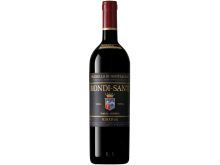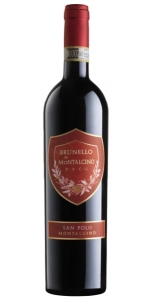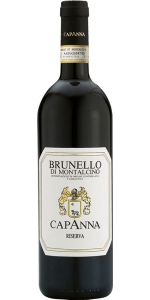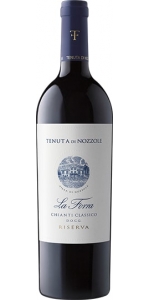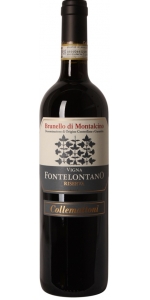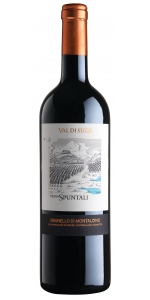Biondi Santi Tenuta Greppo Brunello Riserva 2015
| Country: | Italy |
| Regions: | Tuscany Brunello di Montalcino |
| Winery: | Biondi Santi |
| Grape Type: | Sangiovese |
| Vintage: | 2015 |
| Bottle Size: | 750 ml |
Poggio San Polo Podernovi Brunello di Montalcino is made from Sangiovese.
Intense ruby red in color with garnet hues, clear and glossy. The bouquet exhibits typical aromas of violets and small red berries. Subtle nuances of forest undergrowth, aromatic wood, a touch of vanilla and jammy mixed fruit then give way to subtle hints of coffee. This Brunello is intense, persistent, broad and heady. Full-bodied and warm on the palate, with a densely-woven texture and robust body, it has a persistent finish with well-rounded tannins. The particular features of the terroir at San Polo produce a Brunello with a capacity for lengthy aging, while patient cellaring enhances the wine during ageing in the bottle.
Review:
Lovely purity of fruit with ultra fine tannins and depth, finesse and complexity. Black cherries, cedar and some flowers. It’s full-bodied with very fine tannins that drive the finish. Give it a year or two to open more, but already so enticing. Drink or hold.
-James Suckling 96 Points
The San Polo 2015 Brunello di Montalcino Riserva (with 8,000 bottles produced) is a textured wine with hearty fruit and touches of smoked meat and spice. At its core, the wine offers dark fruit, blackberry and ripe plum. The rich fruitiness of the wine cedes to campfire ash, mahogany and furniture wax. These results are sultry and even a bit flashy, with distant background tones of teriyaki and plum sauce. The wine is fermented in cylindrical oak fermenters and aged in oak for three years. We'll see this bottle hitting the market sometime after February 2021.
-Wine Advocate 95 Points
Capanna Brunello di Montalcino Riserva 2015
TYPE: DOCG
BLEND: 100% Sangiovese carefully selected in the oldest vineyards and only of the best harvests.
VINIFICATION:
Alcoholic fermentation with maceration of the skins (30-35 days) at a controlled temperature and spontaneous malolactic fermentation, both in truncated cone-shaped Slavonian oak vats.
AGEING:
In Slavonian oak casks of 10 to 25 hl for over 40 months; followed by ageing in bottles for at least 15 months.
NOTES:
Colour: deep ruby red, strong, lively.
Bouquet: very intense and complex, fruity and spicy, with red fruit, jam and liquorice shades; great prospects of future development.
Taste: great structure in the acid-tannin components, well supported by the soft ones; extremely persistent.
Food pairings: roast red meats, game and very aged cheeses.
Review:
Powerful, sparkling garnet red. Rich, very appealing nose with notes of ripe raspberries and fresh plums, some liquorice and fine spice notes in the background. Grippy, fine-meshed tannin on the palate, builds up in many layers, salty, good tension, very long finish in the finish.
- Falstaff 98 Points
Tenuta di Nozzole La Forra Chianti Classico Riserva is made from 100% Sangiovese.
Located north of the village of Greve in the heart of the Chianti Classico region, the Nozzole estate covers a striking, rugged, mountainous area of about 1,000 acres at 984 feet in elevation. In order to obtain concentration and complexity in the wine, yields are kept low. The grapes are hand harvested, destemmed and crushed. Fermentation is initiated on the skins in temperature-controlled stainless steel tanks, followed by a maceration period to draw out color and tannins. The wine is racked into stainless steel tanks for malolactic fermentation before aging in oak vats and in bottle before release. The wine is bottled on the estate.
The 2020 vintage was characterized by a basically cold period between April and May and by a generally warm and dry climate until July. The initial slight delay of the vegetative cycle has been recovered since the summer. The sudden increase in temperatures, especially for the later varieties where the fruit set had not yet ended, has favored a production characterized by sparse and light bunches. The stable and sunny climate of the months of August and September allowed the grapes to complete ripening in optimal conditions.
- A classic, traditional Chianti from the Folonari family, making wine since the 1700s
- Matured in oak barrels
- Estate bottled, from a highly regarded estate
Review:
Attractive on the nose with cherries, red berries, dried herbs and baking spices. It’s medium-bodied with fine tannins. Harmonious and poised with a refined character. Weightless and agile. Polished and succulent finish.
-Wine Enthusiast 93 Points
Capanna Brunello di Montalcino Riserva is made from 100 percent Sangiovese.
TYPE: DOCG
BLEND: 100% Sangiovese carefully selected in the oldest vineyards and only of the best harvests.
VINIFICATION:
Alcoholic fermentation with maceration of the skins (30-35 days) at a controlled temperature and spontaneous malolactic fermentation, both in truncated cone-shaped Slavonian oak vats.
AGEING:
In Slavonian oak casks of 10 to 25 hl for over 40 months; followed by ageing in bottles for at least 15 months.
NOTES:
Colour: deep ruby red, strong, lively.
Bouquet: very intense and complex, fruity and spicy, with red fruit, jam and liquorice shades; great prospects of future development.
Taste: great structure in the acid-tannin components, well supported by the soft ones; extremely persistent.
Food pairings: roast red meats, game and very aged cheeses.
Review:
Bright ruby in the glass. First impact is low key, with red cherry, leather, tobacco, fresh violet and balsamic notes. The attack is velvety, with a full body, lifted acidity and dense, ripe tannins. Character emerges from the glass, meaty and bloody. Thick, dry finish that’s fierce. Drink or hold
-James Suckling 95 Points
Collemattoni Brunello di Montalcino Riserva is made from 100 percent Sangiovese.
Intense ruby red with brilliant burgundy reflects in color. Reminiscent of wild black fruits, vanilla and spices on the nose and dry, warm, slightly austere but velvety in the palate.
This wine comes from the oldest vineyard of Collemattoni: Fontelontano. Less than half hectare. It's one of the few Single Vineyard Brunello di Montalcino riserva.
Coming from a parcel with 15-18 year old vines planted in sandy clay and marl soils.
Harvest is 100% destemmed with a soft pressing, fermentation in stainless steel tanks at controlled temperature of 28-30°C, pumping over for the first week of maceration following by skin-contact maceration for 20-25 days with rack and return technique (delestage).
Malolactic fermentation completed. The delestage and the pumping over are then spaced out along the process.
Wine is slightly filtered before bottling.
Review:
This is intense with aromas of dried cherries, sweet licorice, cloves, crushed walnuts and hints of chocolate and undergrowth. Full-bodied, deep and structured with taut, tightly packed tannins. Long and persistent. Drink or hold.
-James Suckling 94 Points
This is a 6 pack with 2 bottles each from vintages from 2013, 2015, and 2016.
***Tenimenti Angelini Val di Suga Vigna Spuntali Brunello di Montalcino 2016:
The 2016 Vigna Spuntali Brunello di Montalcino is the most brooding of the lineup from Val di Suga and is sourced from the southwest of the region on sandy soils. There are aromatics of black raspberry, licorice, menthol, sage, cinnamon, and iron-rich earth. Its Mediterranean influence is felt on the palate with ripe black cherry, dried herbs, and sun-baked earth. This is the fullest bodied and most savory of the Val di Suga lineup, with more roundness and grip. Its structure will benefit from cellaring for several years and will be great drinking over the next 20 years or more. 2026-2040.
-Jeb Dunnuck 96 Points
***Tenimenti Angelini Val di Suga Vigna Spuntali Brunello di Montalcino 2015:
The 2015 Vigna Spuntali Brunello di Montalcino is more introverted on first opening, with notes of black plum, licorice, dried Mediterranean herb, and sun-baked earth. On the palate, it offers a tart dried fruit character, with a building tannin structure that finishes with tomato leaf, and bitter herbs. The most rustic and burly of the wines in the lineup of the 2015 Val di Suga vintage, it will benefit from allowing some time in cellar to see how this matures and its tarriness develops. Drink 2026-2036
-Jeb Dunnuck 94 Points
***Tenimenti Angelini Val di Suga Vigna Spuntali Brunello di Montalcino 2013:
Plenty of spices and fresh herbs on the nose, such as dried rosemary and nutmeg, to match the underlying dried redcurrants and cranberries. Full-bodied with plenty of concentration, but still shows a very sturdy, tannin backbone and punchy acidity, to drive this through to a long finish. Drink in 2021.
-James Suckling 94 Points
Biondi Santi Tenuta Greppo Riserva is made from 100% Sangiovese Grosso.
A rare wine, renowned for its extraordinary ability to age, the Biondi-Santi Riserva is produced only in the best vintages. From 1888 until today, only 41 vintages have been released.
Vineyard Profile
- Grape Source: 100% estate vineyards
- Vine Age: 25 years or older
Vintage Report
A majestic vintage where structure, elegance and freshness combine to form something special. 2015 was a hot and dry year with constant warm temperatures from May through August which permitted the production of perfectly ripe, concentrated grapes. At the beginning of September the “tramontana” a wind coming from the north, refreshed and restored the plants before the final phase of maturation, which was characterized by significant day-night temperature, typical of our high-altitude vineyards.
- Harvest Date(s): Harvest started on September 21st - approximately 10 days later than normal
Vinification
- Aging: The 2015 Riserva was vinified in vertical Slavonian oak barrels by using indigenous yeasts, selected in our vineyards. Successively, it was aged in Slavonian oak barrels for 3 years.
Technical Information
- Varietal Composition: 100% Sangiovese Grosso
- Alcohol: 14.5%
- Optimum Drinking: Serve at 60/64˚ F. Uncork the wine 2 hours before serving.
Tasting Notes
The 2015 Brunello di Montalcino Riserva is a truly majestic wine. The bouquet is packed with intense fruity notes of black berries, pomegranate and plums, intertwined with scents of Mediterranean herbs such as thyme, rosemary and sage, rising from a carpet of forest floor. On the palate, the wine seduces with exuberant charm and caressing sweetness. The youthful tannins reveal its immense structure and contribute to creating a distinctive sensation of freshness which leads us towards a long-lingering, savory finish.
Review:
The Biondi-Santi 2015 Brunello di Montalcino Riserva is initially a reticent wine and one that does not immediately subscribe to the overstated abundance and exuberance of the vintage. Give it time. I wrote this review after several tastings over several days so I could ensure a more accurate account of the wine's elegant reveal. Contemplative and exceedingly nuanced in personality, with wild berry, underbrush, ferrous earth and candied orange peel, this has everything to look forward to in terms of its future evolution in the bottle. It displays a pretty ruby color that borders on garnet and polished copper. A silky, mid-weight palate is accented by beautifully managed and silky tannins (this aspect of the mouthfeel is extraordinary), bright freshness and long-lasting fruit momentum. The alcohol is a bit more powerful in this release (at 14.5%), but the effect is supple and smooth nonetheless. I tasted bottle number 256. Tenuta Biondi Santi does not usually release bottle production numbers, but I can confirm that 2,000 bottles of the 2015 Brunello di Montalcino Riserva are earmarked for the United States market.
-Wine Advocate 98+ Points
It is a rare phenomenon that a wine can trace its origins to a single man. Brunello di Montalcino, however, owes its existence to Ferruccio Biondi-Santi and its fame to his family. Now on the seventh generation of winemakers, the Biondi-Santi family continues to produce wines renowned for their elegance and extraordinary longevity. Located in the heart of Montalcino, the Tenuta Greppo estate spreads over 25 hectares of vines on soils rich in heavy stones and marl – perfect for the cultivation of Sangiovese Grosso. Defenders of a rich enological heritage, the family continues to employ traditional vinicultural methods started well over a century ago to highlight the wine’s unique characteristics, or tipicita.
Franco expanded Il Greppo from 4 acres to 25, but continued to be a staunch believer in traditional viniculture. Today, Franco’s son, Jacopo, and his son, Tancredi, represent the sixth and seventh generations carrying on the family legacy.
Starting in the mid-1800s, Clemente Santi, a renowned writer and scientist, recognized the quality of the vineyards and viticulture at Il Greppo. Long before it became standard practice, Clemente chose to focus on red wines suitable for aging, creating racking and barrel-aging practices far more advanced than his peers’. Clemente’s innovative winemaking earned him considerable recognition, including an award for his “select red wine (Brunello) 1865” at the 1867 Universal Exposition in Paris.
Following in the footsteps of his grandfather, Ferruccio Biondi continued to experiment in the vineyards. In fact, Ferruccio took such pride in the work his grandfather did, he united the two family names and became Ferruccio Biondi-Santi. Ferruccio worked diligently to combat the challenges posed by oidium and phylloxera. He used the work he had already begun on massal selection and identifying mother vines to his advantage, grafting only the best clones on American rootstock and replanting his vineyard with the offspring of the mother clones – propagating what would eventually become the Brunello Biondi-Santi, or BBS 11, clone. Ferruccio also made the bold decision to bottle a 100 percent Sangiovese wine, focusing, like Clemente did before him, on ageworthiness rather than quick profits. With this, the birth of modern-day Brunello di Montalcino began.
After Ferruccio’s death in 1917, his son Tancredi Biondi-Santi continued the line of succession and carried on the family tradition with meticulous care. He looked to the past to secure the future, laying away older vintages in the cellar. He even made the crucial call to secretly wall-up part of his cellar prior to World War II, concealing the oldest Riservas from the Front. In doing so, Biondi-Santi was eventually able to show the world how long-lived and complex Brunello could be. In 1966, Brunello di Montalcino became a DOC and the Italian government turned to Tancredi to assist in writing the regulations.
Tancredi brought the winery to new heights, but it was his son Franco who helped show the world what they could do. Franco traveled far and wide, promoting the wines and showing the power of the old Riservas. The reputation of the wines was only boosted in 1980 when Brunello di Montalcino became the first DOCG in Italy.
Vineyards:
Located just two miles from the town of Montalcino, Il Greppo sits on a 47-hectare parcel of land. The oldest vines on the property are over 80 years old, dating back to 1930. In 1988, Franco Biondi-Santi started an enormous undertaking in the vineyard, eventually increasing plantings from 4 to 25 hectares. He planted the vines on steep terraces, using the natural contour of the hills to create an amphitheater, setting Il Greppo’s cellar at center stage. The soils, rich in a stony marl known locally as galestro, are ideal for the cultivation of Sangiovese Grosso. Dry, warmer weather typically leads to a September harvest. Noted diurnal shifts ensure the characteristic aromas and acid levels that lead to the expressive, long-aging Brunellos typical of the estate.
Thanks to the meticulous cultivation and clonal selection of the different generations, the Brunello Biondi-Santi, or BBS11, became an officially recognized and registered clone – the first to be named after a single producer.
Poggio San Polo Podernovi Brunello di Montalcino is made from Sangiovese.
Intense ruby red in color with garnet hues, clear and glossy. The bouquet exhibits typical aromas of violets and small red berries. Subtle nuances of forest undergrowth, aromatic wood, a touch of vanilla and jammy mixed fruit then give way to subtle hints of coffee. This Brunello is intense, persistent, broad and heady. Full-bodied and warm on the palate, with a densely-woven texture and robust body, it has a persistent finish with well-rounded tannins. The particular features of the terroir at San Polo produce a Brunello with a capacity for lengthy aging, while patient cellaring enhances the wine during ageing in the bottle.
Review:
Lovely purity of fruit with ultra fine tannins and depth, finesse and complexity. Black cherries, cedar and some flowers. It’s full-bodied with very fine tannins that drive the finish. Give it a year or two to open more, but already so enticing. Drink or hold.
-James Suckling 96 Points
The San Polo 2015 Brunello di Montalcino Riserva (with 8,000 bottles produced) is a textured wine with hearty fruit and touches of smoked meat and spice. At its core, the wine offers dark fruit, blackberry and ripe plum. The rich fruitiness of the wine cedes to campfire ash, mahogany and furniture wax. These results are sultry and even a bit flashy, with distant background tones of teriyaki and plum sauce. The wine is fermented in cylindrical oak fermenters and aged in oak for three years. We'll see this bottle hitting the market sometime after February 2021.
-Wine Advocate 95 Points
Capanna Brunello di Montalcino Riserva 2015
TYPE: DOCG
BLEND: 100% Sangiovese carefully selected in the oldest vineyards and only of the best harvests.
VINIFICATION:
Alcoholic fermentation with maceration of the skins (30-35 days) at a controlled temperature and spontaneous malolactic fermentation, both in truncated cone-shaped Slavonian oak vats.
AGEING:
In Slavonian oak casks of 10 to 25 hl for over 40 months; followed by ageing in bottles for at least 15 months.
NOTES:
Colour: deep ruby red, strong, lively.
Bouquet: very intense and complex, fruity and spicy, with red fruit, jam and liquorice shades; great prospects of future development.
Taste: great structure in the acid-tannin components, well supported by the soft ones; extremely persistent.
Food pairings: roast red meats, game and very aged cheeses.
Review:
Powerful, sparkling garnet red. Rich, very appealing nose with notes of ripe raspberries and fresh plums, some liquorice and fine spice notes in the background. Grippy, fine-meshed tannin on the palate, builds up in many layers, salty, good tension, very long finish in the finish.
- Falstaff 98 Points
- back
Lingua Franca The Plow Pinot Noir is made from 100 percent Pinot Noir.
A large proportion of fruit from some of our finest sites, 48% coming from Blocks 1 - 3, planted with PN777 clone. Another 44% is sourced from two blocks of the bold PN 115. The elegant and nuanced PN777 Pinot Noir grown on Gelderman-Jory soils creates the top notes of mineral, rose petal and savory elements while the PN115 provides the fruit, body and weight of the wine.
Loin of lamb, Filet Mignon, veal chop, veal scallopini, pasta with Bolognese sauce, charcuterie, hard cheeses, hamburger, Viennese boiled beef (Tafelspitz), Wienerschnitzel, Kalbi, Bulgogi. Teriyaki, Vietnamese shaking beef, Chinese broccoli beef or Feast of the Immortals? Experimentation is welcome!
Review:
The 2022 Pinot Noir Estate saw 20% whole clusters and 20% new oak. A representation of the vineyard, the blend can vary from year to year. The 2022 is a ripe ruby color and opens to notes of spice and ripe raspberries. Medium-bodied, it’s a great appellation wine, with ripe tannins and a great finish. Drink 2024-2036. A few thousand cases were produced.
-Jeb Dunnuck 94 Points
Long Shadows Cymbal Sauvignon Blanc is made from 100% Sauvignon Blanc.
Tasting notes: Wonderfully vibrant and aromatic, with notes of lemongrass, passion fruit and a hint of honeysuckle. Flavors of mango, fresh herbs and white peach, come together seamlessly across a textured palate and lengthy finish.
Over the years, Gilles and Allen have experimented with small quantities of uniquely styled wines for their personal and family enjoyment. A few of these wines became too good not to share with their “extended family”, including the Cymbal Sauvignon Blanc.
Sauvignon Blanc from three distinct vineyards combined to give this wine its wonderful vibrancy and complex flavor profile. Gamache Vineyard (planted in 1985) is located on a gently sloping hillside in close proximity to the Columbia River. The site benefits from the cooling effect of the river to give the wine fresh acidity. Boushey Vineyard also contributes liveliness and lemongrass character. Bacchus Vineyard Sauvignon Blanc (planted in 1972) is a warmer site, producing a riper style wine that provides a distinct passion fruit character to the
finished blend.

